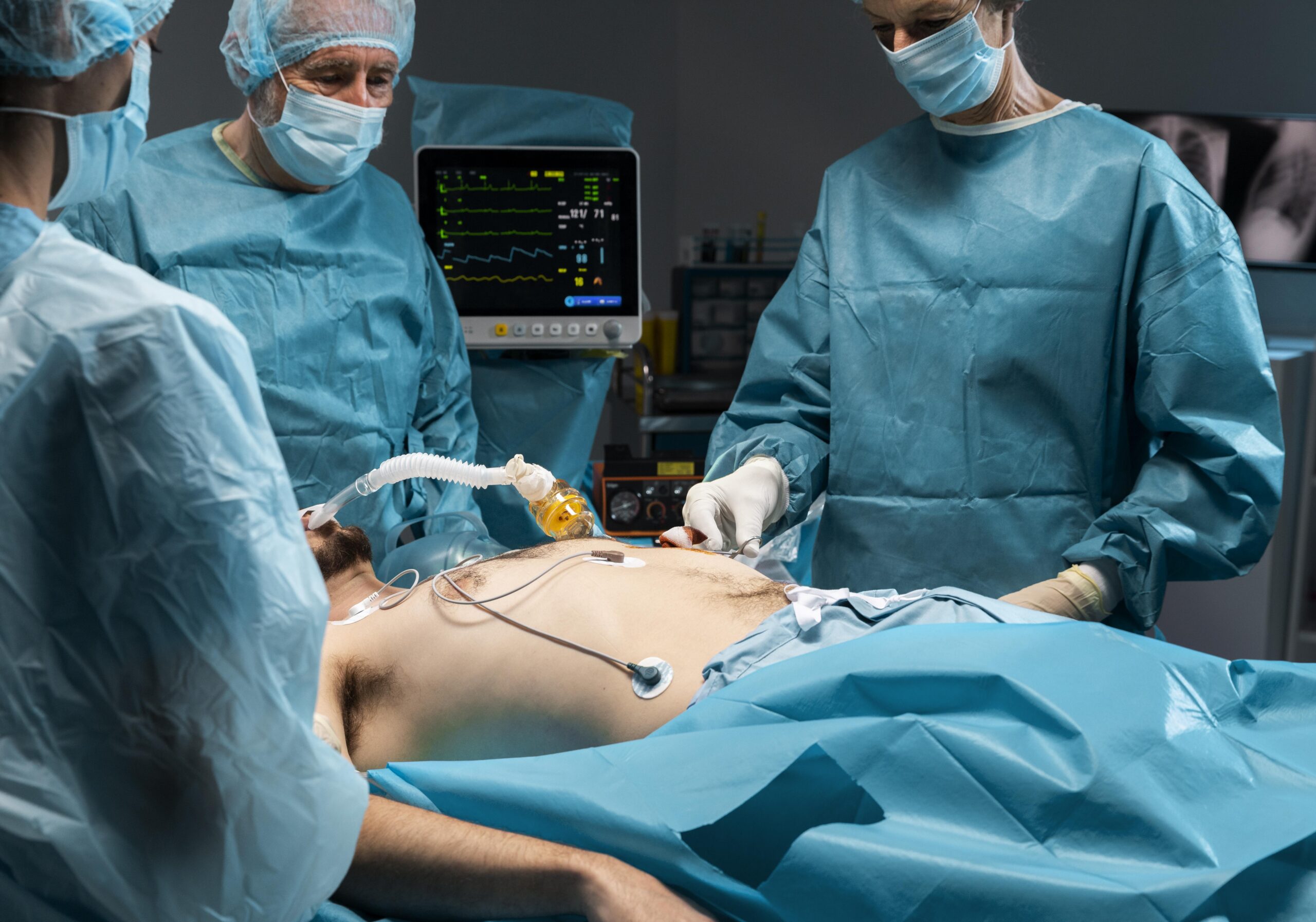Abdominal pain is a condition that affects the inside of the abdominal cavity. It happens that a completely different organ causes this unpleasant ailment. Abdominal pain may suggest minor and severe health problems.
From a biological standpoint, pain is a crucial and often desirable symptom. It encourages us to identify its causes and implement treatments for underlying diseases, preventing severe consequences or even death of the organism. Whether spontaneous or as a result of therapy, its resolution generally indicates a successful disease management outcome.
Pain can be a nuisance when it arises from disorders of the digestive tract, like excessive contraction of smooth muscles or visceral hypersensitivity. However, it becomes a source of suffering when its origin is irremovable, as in cancer pain. In such cases, the pain must be combated to enhance the individual's quality of life.

Abdominal pain may be caused by![]() :
:
This information is indicative. The easiest way is to divide the abdomen into four parts: upper and lower, right and left. These are the so-called quadrants![]() . The dividing lines between these areas run through the navel along and across the body. Often, the pain starts in a specific quadrant but quickly spreads to the entire abdomen. We then talk about diffuse pain.
. The dividing lines between these areas run through the navel along and across the body. Often, the pain starts in a specific quadrant but quickly spreads to the entire abdomen. We then talk about diffuse pain.
The emergence of pain can be sudden, and the patient can quickly determine its onset![]() time. The presence of acute abdominal pain
time. The presence of acute abdominal pain![]() does not necessarily indicate a life-threatening illness. The intensity of the pain may gradually increase from smoldering to severe, as seen in conditions that involve inflammation of the gallbladder, appendix, or diverticula of the large intestine.
does not necessarily indicate a life-threatening illness. The intensity of the pain may gradually increase from smoldering to severe, as seen in conditions that involve inflammation of the gallbladder, appendix, or diverticula of the large intestine.
Notably, severe, sharp pain may be a symptom of the sudden closure of the lumen of a particular segment of the digestive tract, such as intestinal obstruction caused by volvulus or intussusception, perforation resulting from a stomach or duodenal ulcer, or acute ischemia of the abdominal organs, all of which require urgent medical intervention.
Chronic abdominal pain may be recurrent or constant. Constant pain is typically less intense but is still bothersome because it lasts for several days or weeks. Recurrent pain is characteristic of seasonal duodenal ulcers or gynecological disorders that depend on the phase of the menstrual cycle.
Medical consultation![]() is necessary when severe abdominal pain suddenly appears or when the previously experienced pain becomes more and more severe. You should also consult your doctor if your abdominal pain is recurrent or accompanied by any of the following symptoms:
is necessary when severe abdominal pain suddenly appears or when the previously experienced pain becomes more and more severe. You should also consult your doctor if your abdominal pain is recurrent or accompanied by any of the following symptoms:
Symptoms accompanying abdominal pain, which indicate a severe condition of the patient and requires immediate medical attention or calling an ambulance![]() , include:
, include:
The presence of blood in the stool or the black color of the stool is also a disturbing symptom and does not require urgent medical attention (calling an ambulance team). Still, the patient's condition should be consulted by a doctor.
Abdominal pain is often a one-time problem. If the symptoms repeat and are disturbing, you should see a doctor who will diagnose the type of disease. Abdominal pain may also be a symptom of a disease process that has exceeded the limits of home treatment and requires hospital observation in a surgical ward or surgical treatment.
The basis of every medical examination![]() is a medical interview and a physical and additional examination. The doctor collects information about the type of pain and its location.
is a medical interview and a physical and additional examination. The doctor collects information about the type of pain and its location.
Careful interviewing and physical examination are of fundamental importance for planning tests and initiating treatment. Collecting interviews, i.e., a subjective examination, involves asking about the circumstances of the pain, its nature, comorbidities, history of illnesses and surgeries, family history of illness, occupational exposure, etc. The patient's participation is very significant in this part of the diagnosis. It is very important to report all symptoms and precisely answer the doctor's questions regarding their nature and duration.
A physical examination is an assessment that involves examining, percussing, touching (palpating), and listening to the patient's body in search of disease symptoms. Often, based on the history and physical examination, it is possible to establish an accurate diagnosis, complete it, and begin treatment.
Abdominal pain can be acute or chronic. Severe pain may indicate a sudden and serious cause, while less pain may suggest that a medical condition is a disease that has been going on for some time. The location of the pain in the abdomen is particularly important; this applies, for example, to appendicitis, in which the pain is located in the middle of the abdomen and gradually moves to the lower abdomen on the right side.

Laboratory tests![]() and imaging help find the causes of abdominal pain. The doctor refers the patient to a blood count, ESR, liver and pancreatic enzymes, and a general urine test. Patients whose test shows an increased percentage of white blood cells have inflammation in their bodies. If the test shows blood in the urine, we can be almost sure that kidney stones are present, while elevated liver enzymes are revealed when the patient suffers from biliary colic.
and imaging help find the causes of abdominal pain. The doctor refers the patient to a blood count, ESR, liver and pancreatic enzymes, and a general urine test. Patients whose test shows an increased percentage of white blood cells have inflammation in their bodies. If the test shows blood in the urine, we can be almost sure that kidney stones are present, while elevated liver enzymes are revealed when the patient suffers from biliary colic.
Imaging tests![]() for diagnosing abdominal pain primarily include abdominal X-rays, which are helpful if we suspect an obstruction. Another examination may be an abdominal ultrasound, which helps to diagnose, for example, gallstones, appendicitis, ruptured cyst/ovary, or cholecystitis. Computed tomography is also significant in the diagnosis of abdominal pain and is recommended when pancreatic cancer, pancreatitis, or abscesses in the abdominal cavity are suspected.
for diagnosing abdominal pain primarily include abdominal X-rays, which are helpful if we suspect an obstruction. Another examination may be an abdominal ultrasound, which helps to diagnose, for example, gallstones, appendicitis, ruptured cyst/ovary, or cholecystitis. Computed tomography is also significant in the diagnosis of abdominal pain and is recommended when pancreatic cancer, pancreatitis, or abscesses in the abdominal cavity are suspected.
In case of severe abdominal pain, without consulting a doctor, you should not:
If you experience abdominal pain, you should immediately see a doctor because timely surgery saves the patient's life, while surgery performed too late may fail.
Upon completing a thorough conversation and physical examination, a physician develops a preliminary hypothesis and devises further testing to confirm or eliminate it. Laboratory tests and imaging techniques are among the additional tests physicians use. Blood, urine, and stool samples are typical laboratory tests. In contrast, imaging tests allow for visualizing internal organs utilizing non-invasive techniques from the exterior or endoscopic, invasive techniques from the interior.
As mentioned before, imaginary tests, which allow for the presentation of parenchymal organs (such as the liver, pancreas, kidneys, spleen, and lymph nodes), include ultrasonography, computed tomography, and magnetic resonance imaging. Another category of non-invasive imaging tests is classic radiological tests, which are performed less and less frequently, usually with oral contrast or administered through a catheter (e.g. intestinal passage to show the small intestine or double-contrast enema to assess the large intestine).
Endoscopic examinations involve the assessment of individual sections of the digestive tract. Panendoscopy, also known as gastroscopy, is used to directly view the esophagus, stomach, and duodenum, while colonoscopy is used to assess the entire large intestine and sometimes the final several-centimeter fragment of the ileum (small intestine).
Rectal cholangiopancreatography (ERCP) is a specialized endoscopic examination that enables the diagnosis and treatment of biliary tree and pancreas diseases.
Endosonography![]() is a modern examination that enables ultrasound to be performed from the inside of the body to precisely show small details of the structure of organs that are inaccessible to classic ultrasound through the integument. The endosonography device resembles a gastroscope, and the examination does not differ significantly from gastroscopy/colonoscopy for the patient.
is a modern examination that enables ultrasound to be performed from the inside of the body to precisely show small details of the structure of organs that are inaccessible to classic ultrasound through the integument. The endosonography device resembles a gastroscope, and the examination does not differ significantly from gastroscopy/colonoscopy for the patient.
Capsule endoscopy is an expensive, rarely needed, but valuable examination that shows the inside of the small intestine in selected cases. It is unsuitable for examining the stomach or large intestine, which are available using the other, simpler methods mentioned above. It involves swallowing a device the size and shape of a large capsule, containing a light source, a camera, and an image transmitter transmitted to a receiver located on the skin of the abdomen and then read by a doctor using a computer.
Endoscopic examination using cameras inserted through natural body openings allows both the collection of tissue samples for microscopic evaluation and therapeutic procedures (removal of polyps, destruction of abnormal tissues, unblocking using coagulation or prosthetic techniques).
In most cases, the subjective and physical examination and additional tests allow us to determine the cause of pain and to initiate conservative or surgical treatment aimed at eliminating the disease and, therefore, the pain, which may be one of several of the only symptoms of the disease.
Suppose sudden and severe abdominal pain occurs in our presence. In that case, you should immediately call a doctor and place the patient in a comfortable place (the patient should be in a lying position with their legs bent). A cold compress may also provide temporary relief. No medications should be administered until the doctor arrives.
The treatment of abdominal pain depends on its underlying etiology and may entail using medications![]() , such as antispasmodics, analgesics (non-steroidal anti-inflammatory drugs), antidiarrheals, or antibiotics.
, such as antispasmodics, analgesics (non-steroidal anti-inflammatory drugs), antidiarrheals, or antibiotics.
If abdominal pain is caused by indigestion, herbal infusions![]() may be a good idea as they increase the secretion of digestive juices and relax the digestive system's muscles (e.g., chamomile, peppermint, dandelion root). In the case of peptic ulcer disease, it is also worth paying attention to linseed. The seeds encompass mucilage that coats the mucous membranes of the esophagus, stomach, and partly the duodenum, thereby safeguarding them against the corrosive effects of hydrochloric acid.
may be a good idea as they increase the secretion of digestive juices and relax the digestive system's muscles (e.g., chamomile, peppermint, dandelion root). In the case of peptic ulcer disease, it is also worth paying attention to linseed. The seeds encompass mucilage that coats the mucous membranes of the esophagus, stomach, and partly the duodenum, thereby safeguarding them against the corrosive effects of hydrochloric acid.
However, in some situations, surgery![]() is necessary. Irritable bowel syndrome is a challenging condition to treat, in which it is difficult to prevent abdominal pain.
is necessary. Irritable bowel syndrome is a challenging condition to treat, in which it is difficult to prevent abdominal pain.
In most cases, abdominal pain is mild and transient. Usually, pain is a symptom that is not life-threatening and goes away on its own or after lifestyle modification. Sometimes, the symptoms disappear after changing the diet, learning how to cope with stress, or ensuring the regularity of meals. In most cases, mild abdominal pain can be relieved by home remedies. Abdominal pain caused by an infection disappears after it is cured, and the disease does not leave any complications.
Chronic or recurrent abdominal pain may be a symptom of serious health problems. It is important to start treatment immediately so that the patient's condition can improve and even cure the cancer radically.
There are also acute conditions requiring urgent surgical intervention, which, when quickly diagnosed and properly treated, do not necessarily lead to permanent health consequences.

To prevent abdominal pain![]() resulting from incorrect eating habits:
resulting from incorrect eating habits: